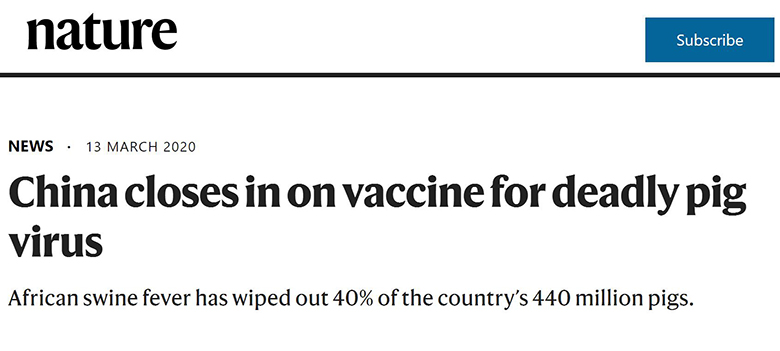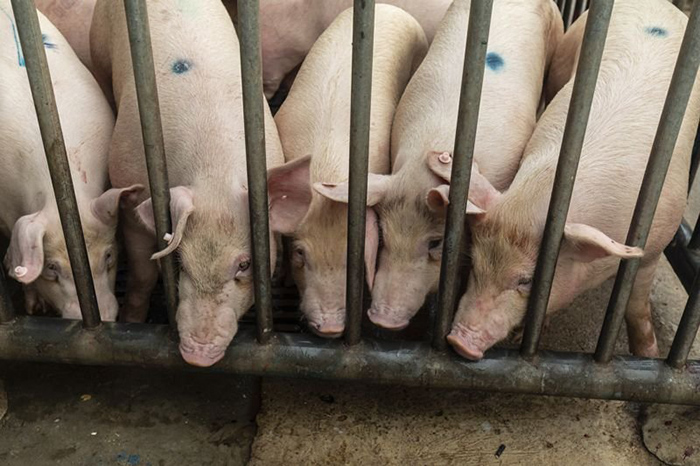

An experimental vaccine against African swine fever can protect pigs for life.Credit: Qilai Shen/Bloomberg/Getty
Researchers in China have developed an experimental vaccine that can protect pigs for life from a lethal virus that has decimated its pig population — the world’s largest — over the past 18 months. But virologists say the team still need to carry out clinical trials and large-scale vaccine production.
There is no available cure or vaccine for the highly contagious African swine fever, a haemorrhagic disease that leads to almost certain death in infected pigs, but does not harm humans.
“A vaccine is desperately needed for the resumption of pig production in China,” says Bu Zhigao, a virologist at Harbin Veterinary Research Institute in China. Bu co-authored a paper on the experimental vaccine that was published earlier this month in Science China Life Sciences1.
China is determined to invest unlimited resources in vaccine development, says Bu. The country has suffered huge economic losses as a result of the virus — China’s pig population of more than 440 million has been reduced by 40% since the virus first appeared in the northeastern city of Shenyang in August 2018 — although the outbreak seems to be under control now, says Bu.
Virologists say that the Chinese team has gone further than any other group in testing the safety and efficacy of a vaccine. The data look promising, says Daniel Rock, a virologist at the University of Illinois at Urbana-Champaign.
Attenuated virus
Bu’s team began their vaccine research after isolating the virus from the spleen of an infected pig. The strain that is currently spreading through China is genetically almost identical to one that was detected in Georgia in 2007, and which spread through eastern Europe before reaching China.
The team’s vaccine approach was to use a live virus and make it less harmful. Pigs exposed to these live attenuated viruses are expected to mount an immune response that protects them from the wild, deadly strain. The approach has been successful in vaccinating animals against classical swine fever and porcine parvovirus, says Rock.
To develop the experimental vaccine, Bu and his team created several strains of the Chinese virus in which they deleted genes known to be involved in disease severity. One of the strains, in which seven genes were deleted, was found to protect four seven-week-old pigs against the virus.
Pigs vaccinated with a high dose of this weakened strain showed only mild symptoms, or none at all, when exposed to the wild virus. This result “is what you would hope to get”, says Linda Dixon, a virologist at The Pirbright Institute near Woking, UK.
In further studies on commercial pigs, Bu’s team found that two rounds of the high dose could protect the pigs for their entire lives, which is typically only five months.
Some risks
The risk with live attenuated vaccines, however, is that they can sometimes mutate into more deadly strains, says Rock. For example, vaccines for African swine fever that were introduced in Spain and Portugal in the 1960s led to the emergence of debilitating, chronic forms of the virus that sometimes killed pigs.
To ensure safety, the Chinese group conducted tests that have not previously been carried out for experimental live attenuated swine fever vaccines, says Rock.
One test involved injecting pigs with the weakened virus, then taking blood samples containing the virus and injecting them into a second group of pigs. The process was repeated over five groups of pigs, with no sign of the weakened virus reverting to a deadlier version. Pregnant sows given the experimental vaccine also delivered healthy piglets, according to the paper.
But Dixon notes that one engineered strain of the virus, in which only six of the seven genes were deleted, did revert to a more harmful form during this passaging process. That needs to be investigated further, she says.
Bu says that extensive laboratory experiments have demonstrated the low risk of reversion for the seven-gene-deleted variant. But before launching a vaccine, his team will run a clinical trial, which will involve some 10,000–20,000 pigs.
Another major impediment to vaccine development has been the absence of a cell line to produce the weakened virus cheaply and in large amounts, says Dixon. A continuously growing cell line that can produce the virus for the vaccine is currently unavailable, she says. But she is now collaborating with Federico Zuckermann, founder of biotechnology company Aptimmune Biologics in Champaign, Illinois, who has developed a potential cell line. They're testing its ability to produce an attenuated vaccine for the Georgia strain.
doi: 10.1038/d41586-020-00742-w
References
1. Chen, W. et al. Sci. China Life Sci. https://doi.org/10.1007/s11427-020-1657-9 (2020).
原文链接:https://www.nature.com/articles/d41586-020-00742-w
